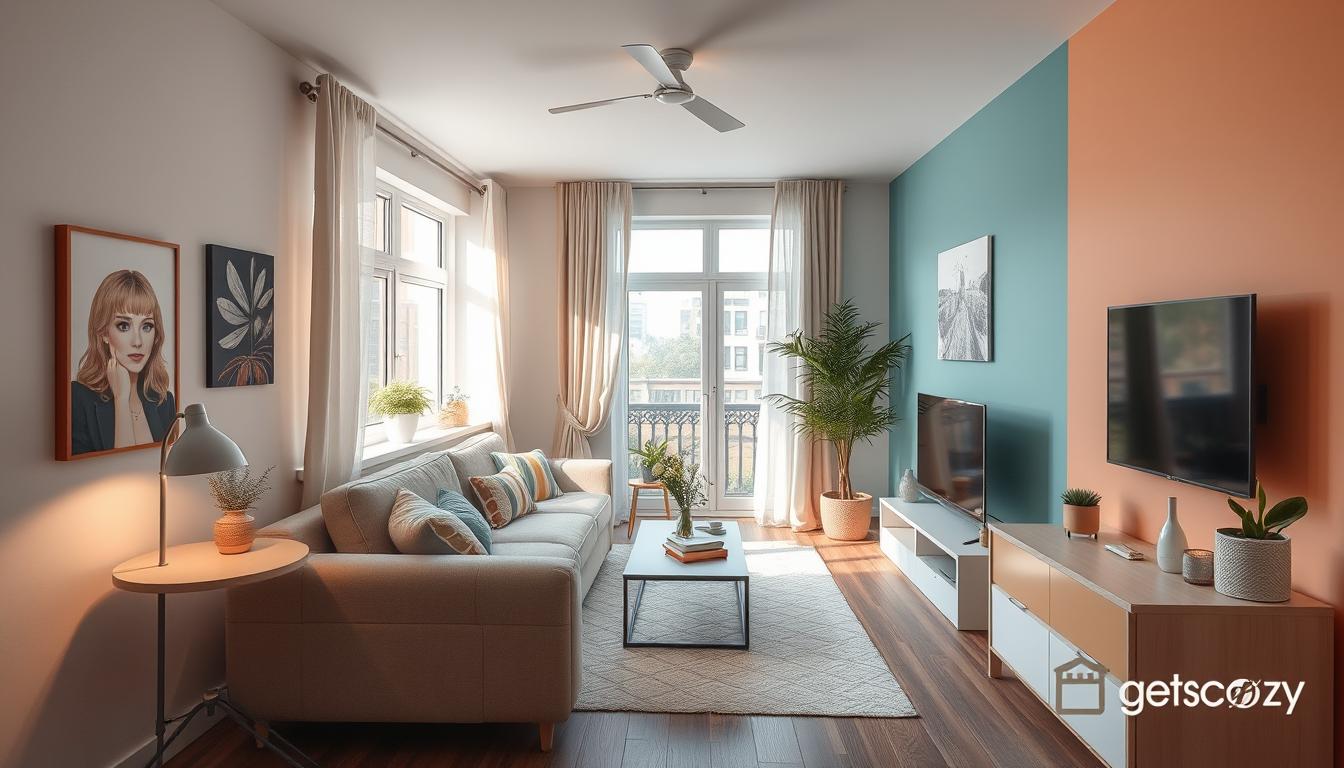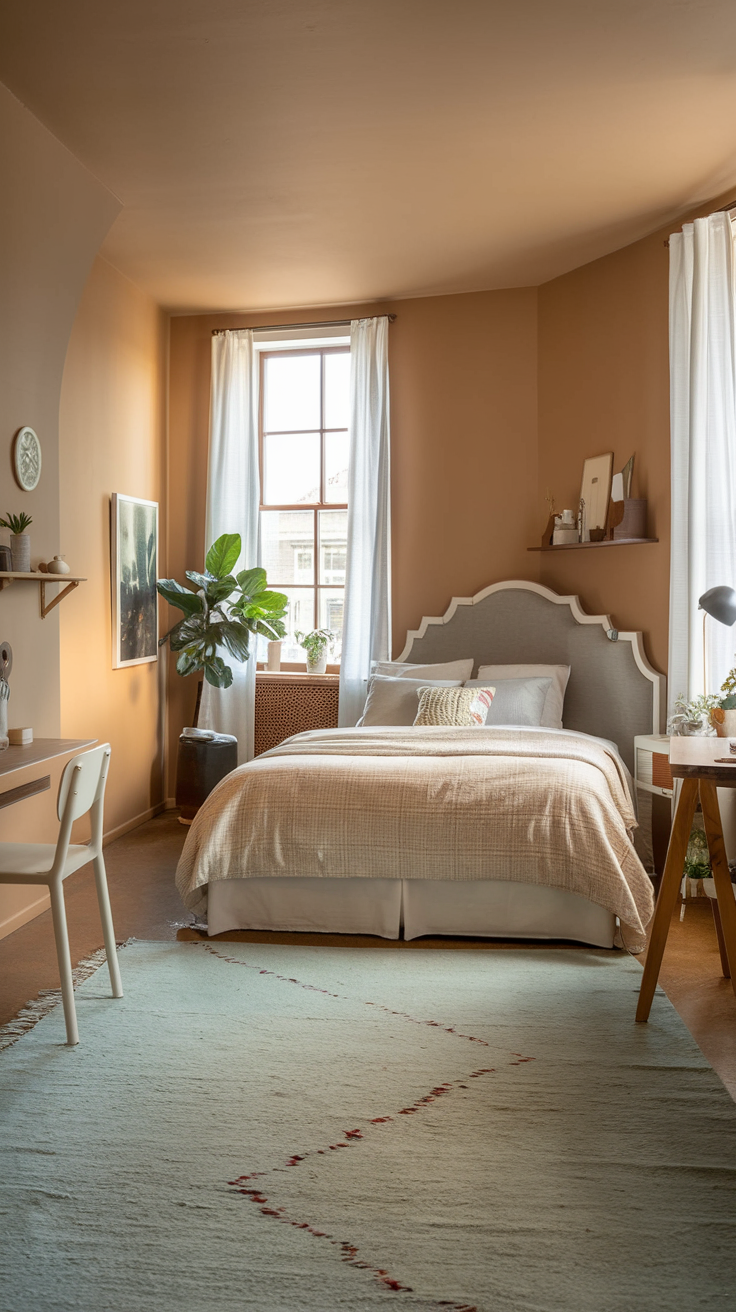Feeling lost with all the color choices for your small apartment? Don’t worry, I’ve got you covered! This guide will show you how to pick the perfect colors for your cozy space. Get ready to see 100 amazing ideas that will make your apartment look its best.
Key Takeaways
- Discover the power of color psychology in small space design
- Learn how to use color to enhance the dimensions of your rooms
- Explore essential principles for creating balanced color schemes
- Unlock the secrets to modern neutral palettes that amplify space
- Get inspired by bold and vibrant color pairings for statement walls
Understanding Color Psychology in Small Space Design
As a passionate designer, I know how much color affects a small apartment. It changes the mood, how we see things, and even the feel of the space. By exploring color psychology, we can make small spaces look great and feel welcoming.
Impact of Colors on Mood and Perception
Colors can make us feel certain ways and affect our happiness. Warm colors like red and orange make us feel energetic. Cool colors like blue and green calm us down. By picking the right colors, we can make our small spaces perfect for relaxing, working, or hanging out.
How Colors Affect Room Dimensions
The size of a room can seem different because of color. Light colors like white and pale blue make rooms feel bigger. Dark colors make rooms feel cozy and intimate. Knowing this helps us make small spaces look bigger.
Creating Balance Through Color
- Choosing colors that work well together is crucial for small spaces.
- Using complementary colors adds interest and balance.
- Picking the right accent colors highlights areas and improves the space’s look.
Exploring room color combination code and color psychology helps us design amazing small spaces. The right colors do more than look good. They create a space that’s good for our minds, bodies, and souls.
Essential Room Color Combination Principles for Apartment Living
Choosing the right colors for your apartment can change everything. Knowing a few key color rules can make your small space look amazing. You can turn your compact area into a stunning, harmonious space.
One important rule is using complementary colors. These are colors opposite each other on the color wheel, like blue and orange. Using them can make your room color combination living room lively and engaging. On the other hand, colors next to each other on the wheel, called analogous, create a calm, unified look.
Color temperature is also key. Warm colors like reds and oranges make a space cozy. Cool colors like blues and greens give it a fresh, apartment living feel. Finding the right balance between these is crucial for a balanced look.
The 60-30-10 color principles rule is a classic. It suggests using a main color for 60% of the space, a secondary color for 30%, and an accent color for 10%. Following this rule helps avoid a cluttered or unbalanced look.
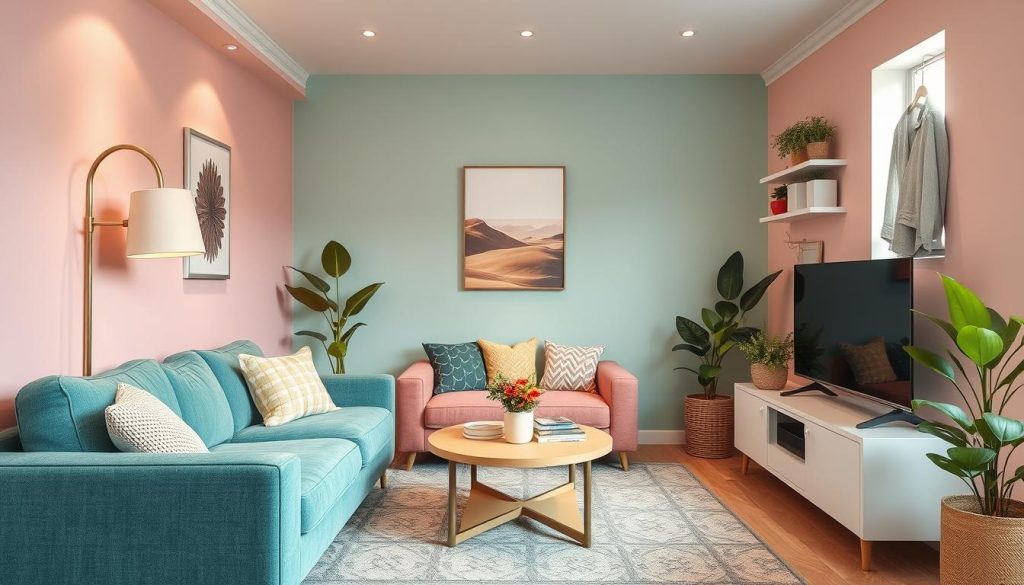
By using these color rules, you can make your small apartment a beautiful, cozy place. Try out different color combinations, balance warm and cool colors, and stick to the 60-30-10 rule. This way, you can create a space that shows off your style and feels livable.
Modern Neutral Color Schemes That Maximize Space
Neutral colors can change the game in small apartments. They add elegance and make spaces feel bigger. Let’s look at some cool ways to mix room color combination neutral, modern color schemes, and space maximization ideas.
Beige and White Combinations
Beige and white together create a warm, airy feel. Using different shades adds texture and depth. This makes your space feel bigger and more welcoming.
Try soft beige walls with white trim, furniture, and decor. It’s a harmonious and elegant choice.
Gray Scale Solutions
Gray scale colors bring sophistication to small spaces. Soft gray walls and charcoal accents create a calm atmosphere. Lighter grays reflect light, making rooms feel bigger.
Darker grays ground the space. This balance makes your room feel serene and expansive.
Earth Tone Palettes
Warm earth tones like beige, tan, and sage work well in small apartments. They match natural materials like wood and stone. This creates a peaceful and grounded feel.
Use these colors on walls and pair with lighter accents and furniture. It keeps your space open and balanced.
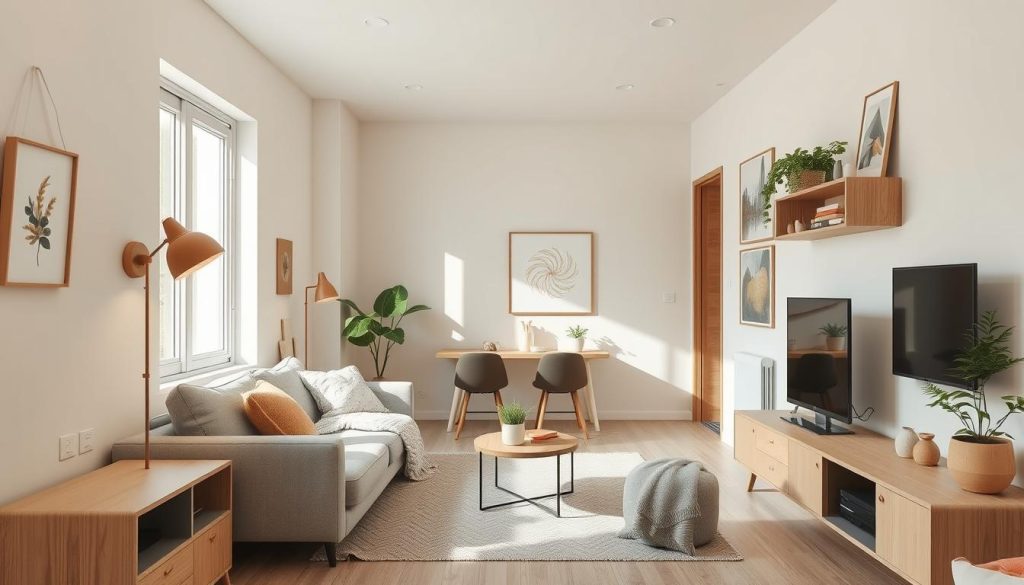
“Neutral color schemes are a versatile and transformative tool in small space design. With the right combinations, you can create a sense of expansiveness and sophistication that belies the compact nature of your apartment.”
Using these room color combination neutral tips can make your small apartment shine. You’ll get a cozy, visually appealing space that feels big and space maximization.
Bold and Vibrant Color Pairings for Statement Walls
Turning a small apartment into a lively space is all about bold colors. Pairing intense colors like red, teal, or orange with neutral tones makes a striking focal point. This doesn’t overwhelm the room.
Vibrant colors add depth, texture, and personality to small living areas. By using these bright shades, you can make your space stand out and show off your style.
Unlocking the Power of Contrasting Colors
To make a stunning statement wall, mix a bright primary color with a neutral tone. For instance, a deep red with white or beige is classic and striking. A bold teal or turquoise looks great with a gray or off-white background.
- Try contrasting colors for visual interest.
- Use bright hues as the main focus, with neutral shades to ground them.
- Add different textures, like matte and glossy, for depth.
Embracing Monochromatic Vibrancy
For a unified look, go for a monochromatic statement wall. Pick a bold color, like orange or teal, and use different shades and tints. This creates a stunning effect.
- Choose a monochromatic scheme for a cohesive look.
- Play with different values and tones of the same color for depth.
- Add textures, like matte and glossy, for interest.
Using bold and vibrant colors on your statement walls can make your small apartment lively and stylish. Try contrasting or monochromatic colors to create a focal point that enhances your home’s design.
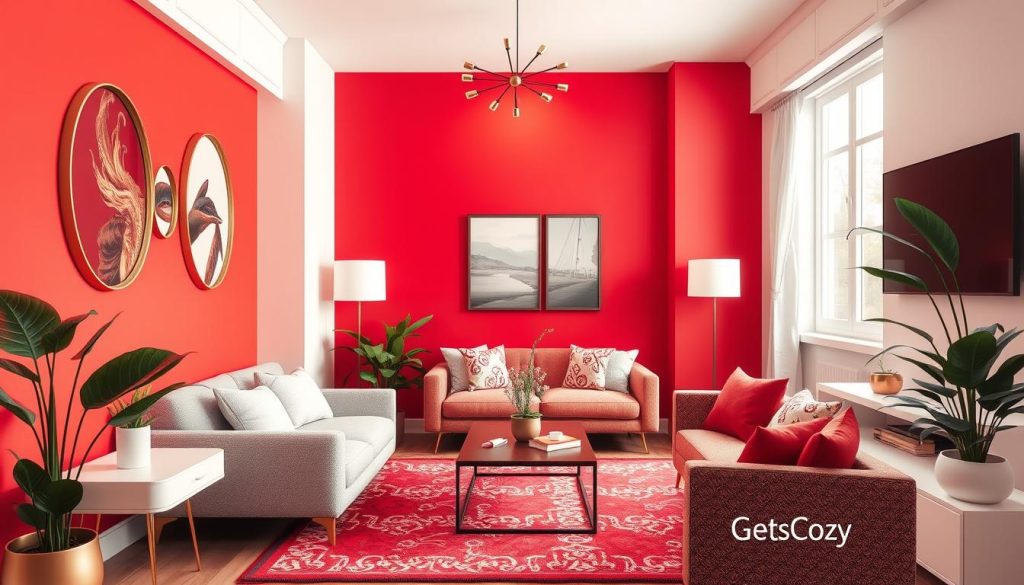
Room Color Combination Trends for 2024
As we enter 2024, it’s time to look at the latest room color trends. These trends are perfect for small apartment dwellers. They include contemporary palettes, sustainable colors, and mixed materials. These ideas will help you create a stylish and functional space.
Contemporary Color Palettes
The old days of neutral colors are over. 2024 will bring bold, vibrant colors to small apartments. Imagine rich jewel tones, soft pastels, and bold color mixes. These colors will make your space look amazing and add depth.
Sustainable Color Choices
- In 2024, we’ll see more eco-friendly colors in our homes.
- Natural pigments and low-VOC paints will be popular. They help make your home healthy and peaceful.
- Earthy tones, greens, and blues will be big. They show our love for sustainable design.
Mixed Material Color Integration
In 2024, mixing textures and materials will be key. You’ll see wood, stone, metal, and glass together. Each adds its own color and feel, making your space interesting and inviting.
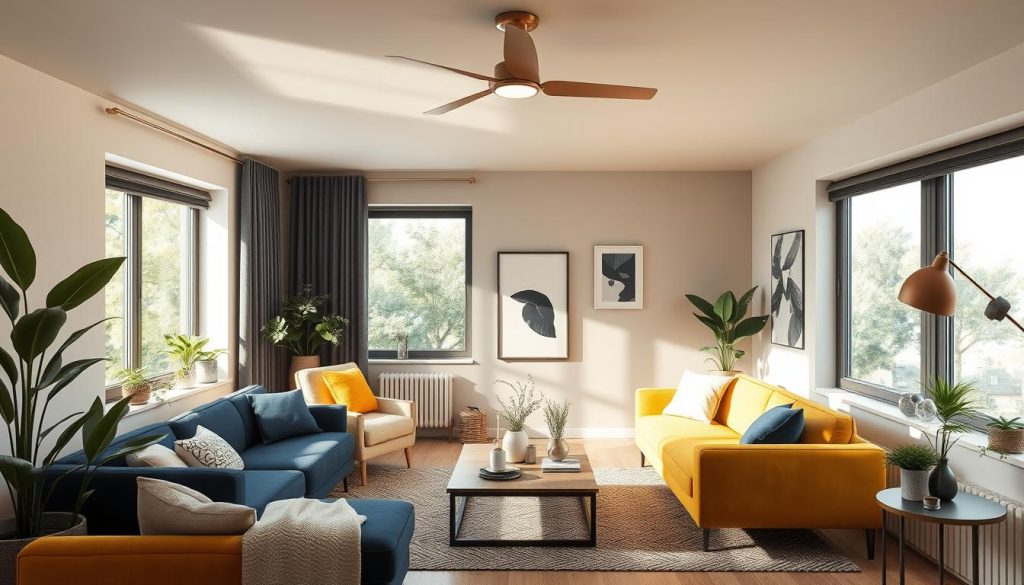
“The true essence of interior design is to create spaces that evoke emotion and inspire the senses.”
Exploring 2024’s room color trends is all about fun and creativity. Use color to make your small apartment show off your style and values.
Small Living Room Color Combinations That Work
Turning a small living room into a stylish space is a fun challenge. The secret is in choosing the right colors. The right colors can make a small room feel bigger, deeper, and more welcoming.
Pairing light colors like soft grays or creamy whites with darker hues for the TV unit is a smart move. This mix balances the room, making it feel open and interesting. Using shades of the same color family, like pale green walls with a deeper olive-toned TV unit, also works well.
To make a room feel taller, use living room color combinations that draw the eye up. Try a light wall color with a darker ceiling. Or, use a monochromatic palette to connect walls and ceiling, making the room feel seamless.
“The right color combination can transform a small living room into a stunning, inviting space that feels much larger than it is.”
The best living room tv unit color combination depends on your style and room features. Try out different colors, mix contrasts, and be creative. With the right colors, your small living room can become a stylish and cozy oasis.
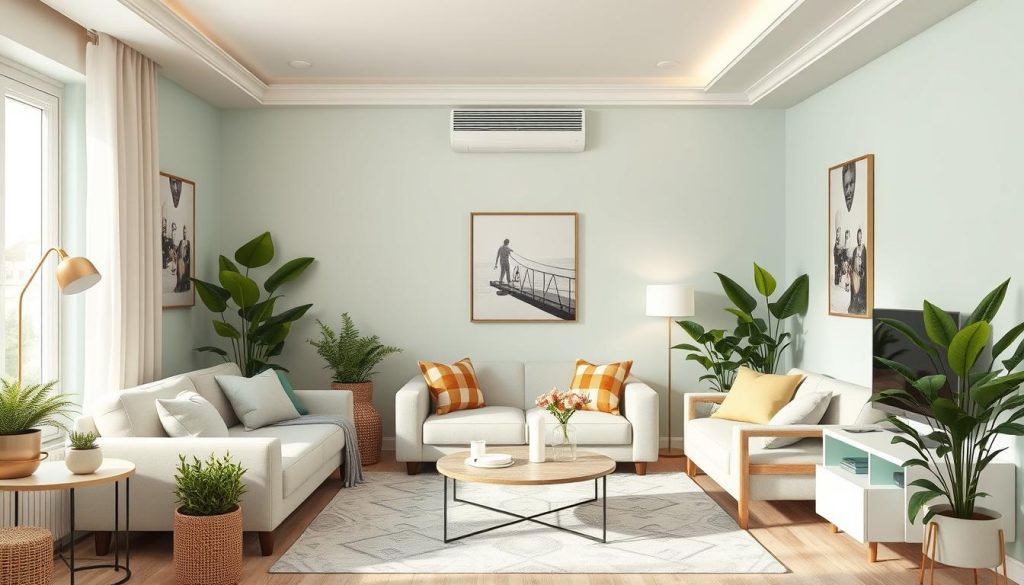
Bedroom Color Schemes for Relaxation and Rest
The bedroom is a special place that needs careful thought. The right colors can make us feel calm and relaxed. Let’s look at how to use colors to make your small apartment a peaceful retreat.
Calming Color Combinations
Soft colors are key for a calm bedroom. Violet colors are soothing and help us feel balanced. Mix these colors with whites or light grays for a peaceful look.
- Add soft lavender to bedding, curtains, or art for calm vibes.
- Use natural wood and textures to add warmth and feel.
- Try different shades of gray for a cozy, relaxation-friendly feel.
Accent Wall Strategies
An accent wall can make a small bedroom feel bigger. A bold color on one wall adds depth and interest.
- Choose deep blues or rich greens for a sophisticated look.
- Try textured wallpapers or murals for added interest.
- Use special lighting to highlight the accent wall and make it cozy.
Textile and Paint Coordination
Matching textiles and paint can make your bedroom feel more cohesive. This creates a peaceful space that looks good together.
Pair soft paint with natural fibers like linen or cotton for a cozy feel. Bold colors in bedding or curtains can match the paint, adding depth and interest.
“The right color combination can transform a small bedroom into a personal haven of relaxation and rejuvenation.”
Kitchen and Dining Area Color Solutions
Turning your kitchen and dining area into stunning spaces is a fun task. As someone who loves interior design, I’ve found that yellow is a great choice. It makes these small areas lively and inviting.
In the kitchen, yellow brightens everything up. It can be a bold backsplash, sunny cabinets, or fun accents. This color makes your kitchen look bigger and more beautiful.
In the dining area, colors set the mood and feel. Adding yellow through walls, furniture, or decor brings warmth. It’s perfect for meals and chats with friends.
| Room Color Combination | Kitchen Solutions | Dining Area Colors |
|---|---|---|
| Yellow and White | Bright and airy kitchen with white cabinets and yellow backsplash | Sunny yellow walls, white table and chairs, natural wood accents |
| Yellow and Gray | Gray cabinets with pops of yellow in the hardware and lighting | Charcoal gray walls, yellow area rug, and metallic light fixtures |
| Yellow and Wood Tones | Yellow tile backsplash with natural wood shelves and butcher block countertops | Warm wood dining table, yellow upholstered chairs, and natural fiber pendant lights |
Exploring these kitchen color solutions and dining area colors helps create a lively space. It shows off your style and brings a sunny feel to your small apartment.
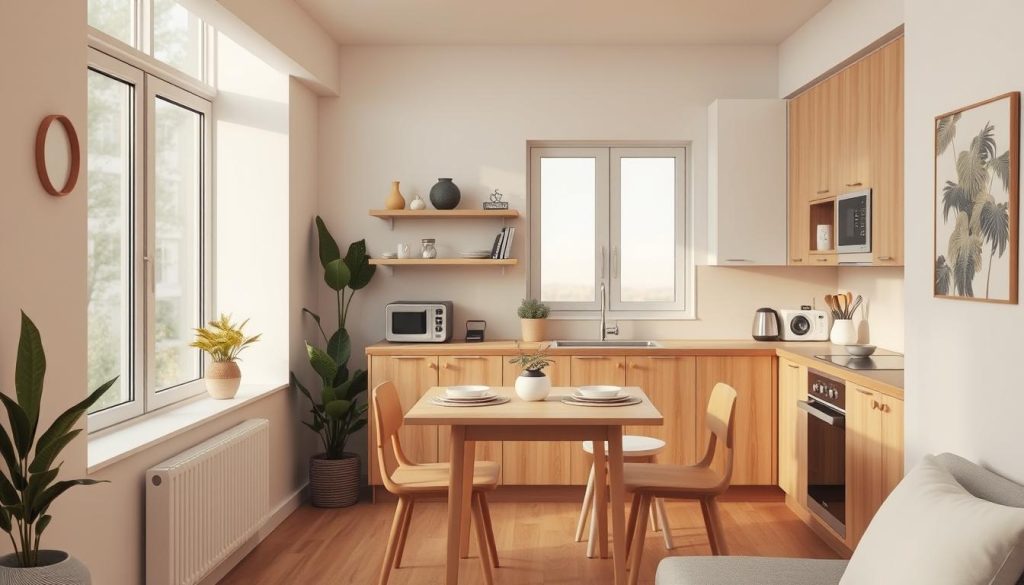
Bathroom Color Combinations for Small Spaces
Choosing the right colors is key for small bathrooms. Cool hues and light colors can make a small space feel bigger. Let’s look at some color combinations that can change a small bathroom into a refreshing space.
Water-Inspired Color Schemes
Teal, aqua, and other water-inspired colors bring a calming vibe to small bathrooms. These colors make the space look bigger and feel more relaxing. Try pairing teal walls with white for a peaceful look.
Light-Enhancing Palettes
Light colors are essential in small bathrooms to let in more light. Soft grays, whites, and pale blues reflect light well, making the space feel airy. Add mirrors to brighten the area even more.
Storage Area Color Integration
Matching storage colors to the walls is important. It makes the bathroom look bigger and more cohesive. Choose light colors for storage to keep the space feeling open.
Choosing the right colors can turn a small bathroom into a peaceful retreat. Use water-inspired colors, light palettes, and matching storage to make the most of your space.
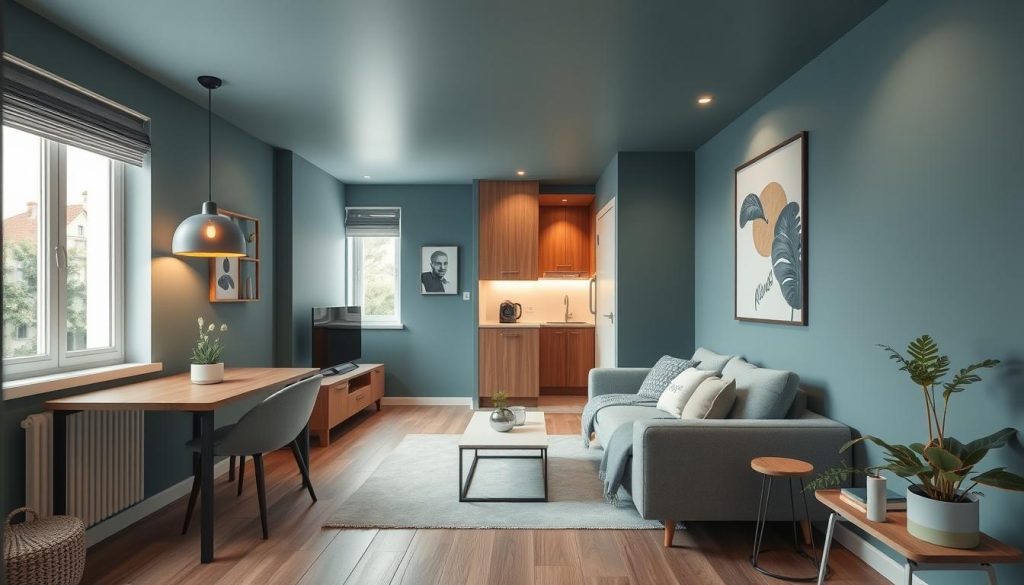
Multi-functional Space Color Planning
Designing a small apartment needs creative solutions to use every inch wisely. One smart way is to plan the room color combination 3d to create different areas in one space. By choosing colors carefully, you can make zones for sleeping, working, and relaxing. This makes your space both beautiful and practical.
Understanding how colors affect a room is key to good color planning. Cooler shades like blues and greens can calm a space, while warmer tones like reds and oranges add energy. Use 3D tools to see how different colors can change your small apartment’s feel and use.
- Use contrasting colors for different zones: A calm neutral for the living area and a bright color for the office.
- Colors can make a space feel bigger or cozier: Light colors open up a space, while dark colors create cozy spots.
- Choose furniture that fits the color scheme: Pick pieces that match the colors around them.
| Room Color Combination 3d | Design Goal | Color Palette |
|---|---|---|
| Living Area | Relaxation and Entertaining | Soft Gray, Warm White, Subtle Blue Accents |
| Home Office | Productivity and Focus | Sage Green, Mustard Yellow, Natural Wood Tones |
| Sleeping Zone | Calm and Restful Retreat | Muted Lavender, Soft Cream, Touches of Warm Metallics |
By planning your room colors well, you can turn a multi-functional space into a beautiful and functional place. Color can help define areas, improve how a space feels, and make your small space feel like your own.
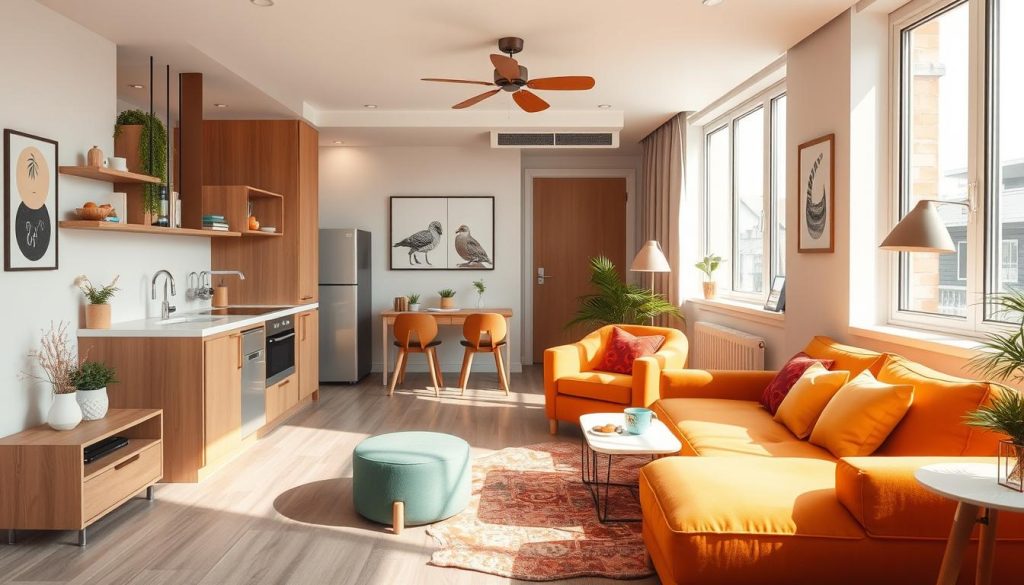
Color Combinations for Home Office Corners
Turning a small apartment into a productive home office needs smart color choices. Pick colors that help you focus and add storage solutions. This way, you’ll have a space that’s both useful and looks good, helping you work better.
Focus-Enhancing Colors
Some colors can make you more focused and clear-headed. Warm, earthy tones like maroon are great. They make you feel grounded and can be used on walls or in furniture.
Video Conference-Friendly Backgrounds
With remote work, your home office colors matter for video calls. Choose colors that look professional and keep distractions away. Soft grays or muted blues are good choices. They make your space look clean and professional for meetings.
Storage Integration Colors
Having enough storage in a small office is key. Pick colors for your storage that match your office. Use colors that go well with your walls and furniture. This makes your space look better and more organized.
| Color | Benefit |
|---|---|
| Maroon | Promotes focus and concentration |
| Gray | Creates a professional, distraction-free backdrop for video calls |
| Complementary Colors | Integrates storage solutions with the overall color scheme |
Choosing the right room color combination maroon, home office colors, and focus-enhancing hues can make your small apartment a great home office. It will help you work well and feel good.
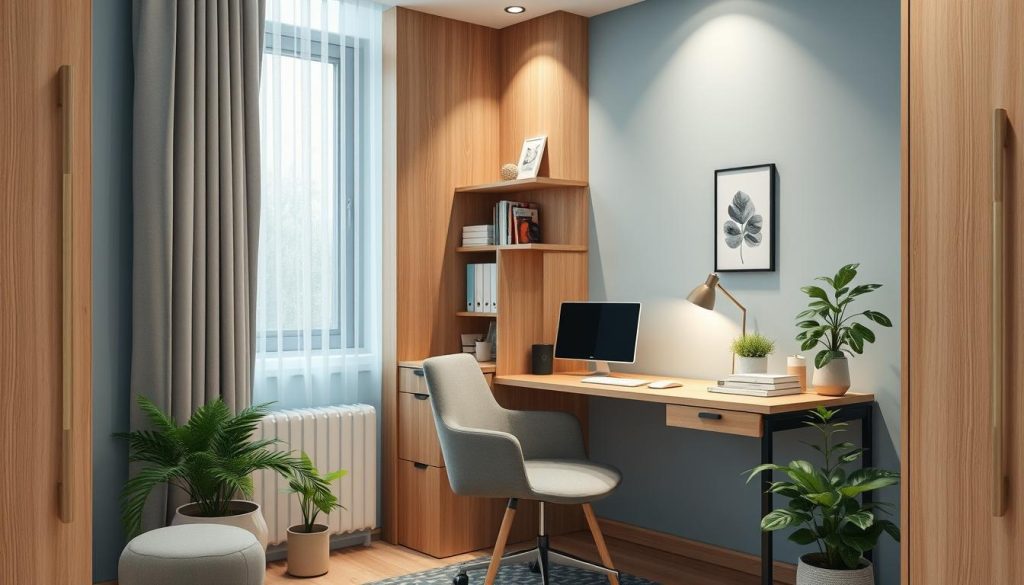
Maximizing Natural Light Through Color Selection
Decorating a small apartment can be a challenge. But, using color wisely can make a big difference. By picking colors that reflect light and match your view, you can brighten up your space. This makes your home feel bigger and more welcoming.
Choosing light, airy colors is key to enhancing natural light. Pale blues, soft greens, and crisp whites are great. They reflect light well, making your room look bigger and feel airier.
It’s also important to think about how your colors match the view outside. Room color combinations that complement the natural light and views from your windows are best. This creates a smooth transition between inside and outside. It makes your small apartment feel more spacious and bright.
| Color Selection | Impact on Natural Light |
|---|---|
| Pale Blues | Highly reflective, creates an airy, open feel |
| Soft Greens | Enhances the connection to nature, adds a calming ambiance |
| Crisp Whites | Maximizes light reflection, makes spaces feel larger |
By choosing the right room color combination exterior and colors, you can turn your small apartment into a bright, cozy space. It will feel spacious and look great.
“Color is an essential element in creating a sense of openness and light within a small living space.”
Seasonal Color Transition Strategies
As seasons change, our small apartments need a refresh. We can switch our room colors to match nature’s palette. It’s easy to change from cool tones in winter to warm ones in fall. This way, our apartments stay stylish and adaptable all year.
Summer to Fall Adaptations
When summer ends, autumn brings rich, earthy tones. Replace bright colors with room color combination orange, deep reds, and mustard yellows. These colors bring the cozy feel of autumn leaves inside. Add plush textiles like velvet throw pillows or a chunky knit blanket to make the space feel cozy.
Winter to Spring Transitions
As winter ends, spring brings light colors. Welcome the new season with soft pastels, serene blues, and floral patterns. Replace heavy curtains with light, airy ones to let in more sunlight. Add potted plants or fresh greenery to bring life and freshness to your space.
Versatile Year-Round Options
- Choose adaptable designs like neutral furniture or modular shelves that change with the seasons.
- Use timeless colors like crisp white and pale gray that look good all year.
- Add natural materials like wood, stone, or rattan for a grounding, earthy feel.
By using seasonal color transitions and adaptable designs, your small apartment can change with the seasons. This way, you can enjoy a beautiful and cohesive living space all year.
Budget-Friendly Color Combination Implementation
Make your small apartment look amazing without spending a lot. I’ll show you how to use DIY tricks and cheap paint to get the look you want. With three-color combos, you can make spaces that show off your style.
Paint is a cheap way to add color. Look for affordable brands that still offer great quality. You can mix and match these paints to find your perfect colors. This way, you can try out different looks without spending too much.
If you like making things, try DIY projects. You can use old items or furniture to add color to your space. By using three colors together, even simple projects can look amazing.

